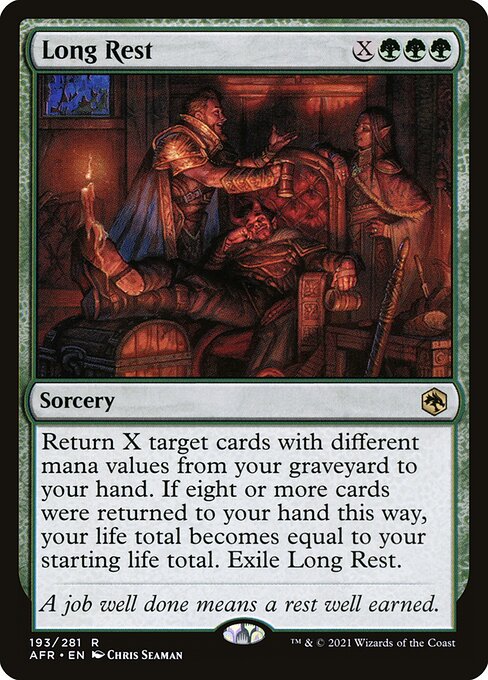
Image courtesy of Scryfall.com
Charting Green's Potential: Color Distribution and Long Rest in MTG Heatmaps
Green has always been a color of resilience, growth, and big, splashy turns. When a card like Long Rest enters the battlefield in Adventures in the Forgotten Realms, it invites a flavor of control and curiosity: pay X with {G}{G}{G}, then return X cards with different mana values from your graveyard to your hand. If eight or more cards were returned this way, your life total snaps back to its starting value, and the spell exiles. It’s a clever dance of tempo and inevitability, a moment where the heatmaps of mana values across your deck become the map you navigate with every draw. 🧙♂️🔥
To appreciate the power and nuance of Long Rest, you need to see the color distribution through a practical lens. Heatmaps built around green-heavy decks reveal how often you’ll land on diverse mana values in the graveyard and in your hand, and how those values influence your return-from-graveyard engine. The card’s X in the mana cost means you’re not just spelunking for a single, tidy payoff; you’re orchestrating a spectrum of mana values that must coexist in the same spell. In the AFR setting, where ramp, card draw, and graveyard shenanigans mingle, Long Rest sits at the intersection of momentum and forgiveness. 💎
Where Long Rest fits in the green toolbox
Long Rest is a rare gem in the AFR slot—rare in rarity and in the way it reverses a classic graveyard play into a potential life-total reset. In a deck that emphasizes creatures, ramp, and value recursion, you can engineer a sequence where you safely exile Long Rest after it triggers its effect, then reload your options from the graveyard with a satisfying diversity of mana values. Its effect demands careful planning: you want X cards with different costs, so your graveyard becomes a micro-lactory of possibilities. The triple-green mana cost constrains the total mana you can reasonably pour into the spell, but the X component rewards you for spreading your resources across a broad spectrum. And for players who enjoy the thrill of the high-variance, the possibility of reaching that eight-card threshold and snapping back to starting life total is an exhilarating payoff. ⚔️
“A job well done means a rest well earned.” — flavor text for Long Rest
From a design standpoint, Long Rest embodies what green does best: bend the pile of cards you’ve accumulated into a single, memorable engine. The card encourages you to populate your graveyard with a mix of mana values—think a carefully curated mix of low, mid, and high costs—so that your retrieved hand feels varied, dynamic, and capable of swinging a game in your favor. The life-total-reset clause adds a neat safety valve to the equation: if your plan spirals a bit too quickly, eight cards returned can give you a second wind, a thematic nod to the concept of a long, restorative pause between battles. 🎨
Practical deck-building takeaways
- Mana value diversity matters. Since you must return X cards with different mana values, your graveyard and hand benefit from a spread of costs, not a stack of duplicates. A well-curated graveyard makes the “X” feel less like a gamble and more like a plan.
- XL ramp and draw pair nicely with Long Rest. Pair green ramp with draw effects so you can fill the graveyard quickly and then refill your hand with a satisfying array of options.
- Go wide on targets. Because you want different mana values, include a mix of small and mid-range spells that can be safely returned without leaving you stuck with a hand full of pricey options.
- Mind the exile clause. Exiling Long Rest keeps the graveyard-into-hand loop from looping forever, but it also gives you space to rebuild your strategy around the card’s payoff rather than a single perpetual engine.
- Commander-friendly appeal. In singleton formats, the chosen pool of graveyard cards can be especially impactful, turning green’s natural value engine into a long-game strategy that rewards patient play and careful sequencing. 🧙♂️
When you map these ideas onto heatmaps, the value becomes tangible. The green color distribution often peaks around midrange flexible spells, with a sprinkling of high-minale value cards that create big returns. Long Rest doesn’t demand a perfect balance, but it rewards thoughtful curation: you want a broad spread of costs and a plan for how you’ll refill your hand after the fetch-and-restore moment. This is the core appeal of heatmaps in MTG analytics—seeing where your deck’s mana-value footprints lie and how cards like Long Rest can turn those footprints into a strategic path forward. 🧭
Flavor, art, and the broader vibe
The art by Chris Seaman captures a restorative moment—a resting figure amid a dynamic battlefield, a visual nod to the card’s flavor text. In a game known for epic spells and towering creatures, Long Rest reminds us that the best victories often come after a thoughtful pause. The display of green’s vitality and resilience—paired with an unusual life-total twist—speaks to the green mindset: keep the engine warm, preserve the pieces, and let a well-timed reset set the stage for a dramatic finish.
For fans who love the intersection of strategy, lore, and aesthetics, this card is a microcosm of the AFR set’s charm: a grounded, nature-centered mythos that honors the craft of deck-building, the joy of discovery, and the beauty of a well-timed long rest. 🧙♂️⚔️
Non-Slip Gaming Neon Mouse PadMore from our network
- https://blog.crypto-articles.xyz/blog/post/alakazam-in-the-meta-decks-revealing-key-matchup-statistics/
- https://crypto-acolytes.xyz/blog/post/vitaspore-thallid-connections-to-classic-mtg-story-arcs/
- https://blog.digital-vault.xyz/blog/post/best-cards-to-amplify-pack-leader-in-mtg-commander/
- https://blog.zero-static.xyz/blog/post/phyrexian-harvester-shines-in-multiplayer-commander-games/
- https://blog.zero-static.xyz/blog/post/starfield-vocalist-and-the-magic-of-community-humor/